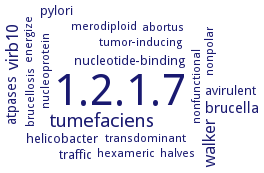1.2.1.7: benzaldehyde dehydrogenase (NADP+)
This is an abbreviated version!
For detailed information about benzaldehyde dehydrogenase (NADP+), go to the full flat file.

Reaction
Synonyms
4-hydroxy benzaldehyde dehydrogenase, 4-hydroxybenzaldehyde dehydrogenase, mdlD, More, NAD(P)-dependent benzaldehyde dehydrogenase, NADP-linked benzaldehyde dehydrogenase, PpBADH
ECTree
Advanced search results
General Information
General Information on EC 1.2.1.7 - benzaldehyde dehydrogenase (NADP+)
Please wait a moment until all data is loaded. This message will disappear when all data is loaded.
evolution
metabolism
additional information
benzaldehyde dehydrogenase from Pseudomonas putida (PpBADH) belongs to the Class 3 aldehyde dehydrogenase (ALDH) family. The Class 3 ALDHs are unusual in that they are generally dimeric (rather than tetrameric), relatively non-specific and utilize both NAD+ and NADP+. The pattern of cofactor binding for the rat Class 3 ALDH differs from that of PpBADH and other ALDHs
evolution
-
benzaldehyde dehydrogenase from Pseudomonas putida (PpBADH) belongs to the Class 3 aldehyde dehydrogenase (ALDH) family. The Class 3 ALDHs are unusual in that they are generally dimeric (rather than tetrameric), relatively non-specific and utilize both NAD+ and NADP+. The pattern of cofactor binding for the rat Class 3 ALDH differs from that of PpBADH and other ALDHs
-
benzaldehyde dehydrogenase (PpBADH) is the terminal enzyme in the mandelamide/mandelate pathway of Pseudomonas putida strain ATCC 12633, it catalyzes the conversion of benzaldehyde to benzoic acid with the concomitant reduction of NAD+ (EC 1.2.1.28) or NADP+ (EC 1.2.1.7) to NADH or NADPH, respectively. Benzoic acid subsequently enters the beta-oxoadipate pathway and the citric acid cycle
metabolism
-
benzaldehyde dehydrogenase (PpBADH) is the terminal enzyme in the mandelamide/mandelate pathway of Pseudomonas putida strain ATCC 12633, it catalyzes the conversion of benzaldehyde to benzoic acid with the concomitant reduction of NAD+ (EC 1.2.1.28) or NADP+ (EC 1.2.1.7) to NADH or NADPH, respectively. Benzoic acid subsequently enters the beta-oxoadipate pathway and the citric acid cycle
-
two conserved glutamates, at positions 215 and 337, act as the general base necessary to hydrolyze the thioacyl intermediate, structure-activity relationship, mechanism, overview. Glu215 is the likely candidate for PpBADH, a result more typical of the Class 1 and 2 ALDH families. Hydride transfer is not rate limiting, lending further credence to the suggestion that PpBADH is more similar to the Class 1 and 2 ALDHs than it is to other Class 3 ALDHs. Structure comparisons
additional information
-
two conserved glutamates, at positions 215 and 337, act as the general base necessary to hydrolyze the thioacyl intermediate, structure-activity relationship, mechanism, overview. Glu215 is the likely candidate for PpBADH, a result more typical of the Class 1 and 2 ALDH families. Hydride transfer is not rate limiting, lending further credence to the suggestion that PpBADH is more similar to the Class 1 and 2 ALDHs than it is to other Class 3 ALDHs. Structure comparisons
additional information
-
two conserved glutamates, at positions 215 and 337, act as the general base necessary to hydrolyze the thioacyl intermediate, structure-activity relationship, mechanism, overview. Glu215 is the likely candidate for PpBADH, a result more typical of the Class 1 and 2 ALDH families. Hydride transfer is not rate limiting, lending further credence to the suggestion that PpBADH is more similar to the Class 1 and 2 ALDHs than it is to other Class 3 ALDHs. Structure comparisons
-


 results (
results ( results (
results ( top
top






